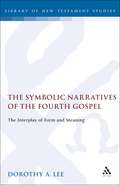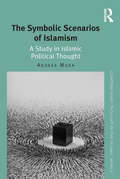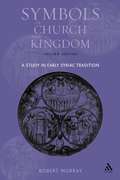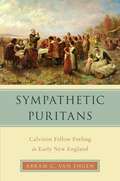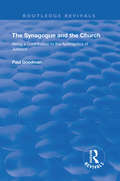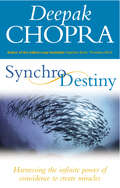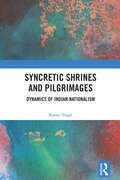- Table View
- List View
Symbolic Houses in Judaism: How Objects and Metaphors Construct Hybrid Places of Belonging (Ashgate Studies in Architecture)
by Mimi Levy LipisInvestigating Jewish spatial practices by exploring the symbol of the house in Judaism, this book examines two groups of houses: ritual objects based on the iconology of the house (ritual houses) and house metaphors (the text, community and the covenant with god as house). This unique pairing is explored as place-making tools which exist in a constant state of tension between diaspora and belonging. Containing many photographs of historical and contemporary artefacts from Europe, Israel and the United States, this book maps out the intersection of architecture, Jewish studies, cultural and gender studies and opens up the discussion of distinctly Jewish objects and metaphors to discourses taking place outside explicitly Jewish contexts.
Symbolic Houses in Judaism: How Objects and Metaphors Construct Hybrid Places of Belonging (Ashgate Studies in Architecture)
by Mimi Levy LipisInvestigating Jewish spatial practices by exploring the symbol of the house in Judaism, this book examines two groups of houses: ritual objects based on the iconology of the house (ritual houses) and house metaphors (the text, community and the covenant with god as house). This unique pairing is explored as place-making tools which exist in a constant state of tension between diaspora and belonging. Containing many photographs of historical and contemporary artefacts from Europe, Israel and the United States, this book maps out the intersection of architecture, Jewish studies, cultural and gender studies and opens up the discussion of distinctly Jewish objects and metaphors to discourses taking place outside explicitly Jewish contexts.
The Symbolic Jesus: Historical Scholarship, Judaism and the Construction of Contemporary Identity (Religion in Culture)
by William E. ArnalIt is widely accepted that Jesus was a Jew. However, both Christian and New Testament scholarship have a strong anti-Jewish history. 'The Symbolic Jesus' presents the controversies surrounding the Jewishness of Jesus. It examines the insistence among historical Jesus scholars that Jesus was a Jew and the ways this frames the figure of Jesus in ancient Christian literature. The book examines the anti-Jewish legacy of the past and more recent approaches to biblical scholarship. Contemporary identity issues - scholarly, political, religious and cultural - are shown to lie at the heart of the debate.
The Symbolic Jesus: Historical Scholarship, Judaism and the Construction of Contemporary Identity (Religion in Culture)
by William E. ArnalIt is widely accepted that Jesus was a Jew. However, both Christian and New Testament scholarship have a strong anti-Jewish history. 'The Symbolic Jesus' presents the controversies surrounding the Jewishness of Jesus. It examines the insistence among historical Jesus scholars that Jesus was a Jew and the ways this frames the figure of Jesus in ancient Christian literature. The book examines the anti-Jewish legacy of the past and more recent approaches to biblical scholarship. Contemporary identity issues - scholarly, political, religious and cultural - are shown to lie at the heart of the debate.
The Symbolic Narratives of the Fourth Gospel: The Interplay of Form and Meaning (The Library of New Testament Studies #95)
by Dorothy LeeThe book examines six long narratives of the Fourth Gospel, arguing that they are best understood as 'symbolic narrative'. They display a unique cohesion of symbol and narrative: the narrative unfolds the symbol and the symbol draws out the narrative. This process occurs as the character struggles to understand the symbolic meaning. The structure develops in five Stages: the establishing of a 'sign', image or feast (Stage 1); misunderstood in materialistic terms (Stage 2); the struggle to understand the symbolic meaning (Stage 3); the acceptance or rejection of that meaning (Stage 4); a confession of faith or statement of rejection (Stage 5). The symbolic narratives reveal how material reality becomes symbolic of the divine. Just as the flesh of Jesus is the symbol of divine glory, so material reality now has the potential for symbolizing God. Flesh has no independent existence; its value lies in its symbolic role. This parallels the cohesion between form and meaning. Just as the flesh is given value in symbolizing the divine, so narrative form is of value in disclosing theological meaning. The implied reader is drawn into the drama of the symbolic narratives to make the authentic response of faith.
The Symbolic Scenarios of Islamism: A Study in Islamic Political Thought (Contemporary Thought in the Islamic World)
by Andrea MuraThe Symbolic Scenarios of Islamism initiates a dialogue between the discourse of three of the most discussed figures in the history of the Sunni Islamic movement—Hasan al-Banna, Sayyid Qutb, and Osama bin Laden—and contemporary debates across religion and political theory, providing a crucial foundation upon which to situate current developments in world politics. Redressing the inefficiency of the terms in which the debate on Islam and Islamism is generally conducted, the book examines the role played by tradition, modernity, and transmodernity as major "symbolic scenarios" of Islamist discourses, highlighting the internal complexity and dynamism of Islamism. By uncovering forms of knowledge that have hitherto gone unnoticed or have been marginalised by traditional and dominant approaches to politics, accounting for central political ideas in non-Western sources and in the Global South, the book provides a unique contribution towards rethinking the nature of citizenship, antagonism, space, and frontiers required today. While offering valuable reading for scholars of Islamic studies, religious studies and politics, it provides a critical perspective for academics with an interest in discourse theory, post-colonial theory, political philosophy, and comparative political thought.
The Symbolic Scenarios of Islamism: A Study in Islamic Political Thought (Contemporary Thought in the Islamic World)
by Andrea MuraThe Symbolic Scenarios of Islamism initiates a dialogue between the discourse of three of the most discussed figures in the history of the Sunni Islamic movement—Hasan al-Banna, Sayyid Qutb, and Osama bin Laden—and contemporary debates across religion and political theory, providing a crucial foundation upon which to situate current developments in world politics. Redressing the inefficiency of the terms in which the debate on Islam and Islamism is generally conducted, the book examines the role played by tradition, modernity, and transmodernity as major "symbolic scenarios" of Islamist discourses, highlighting the internal complexity and dynamism of Islamism. By uncovering forms of knowledge that have hitherto gone unnoticed or have been marginalised by traditional and dominant approaches to politics, accounting for central political ideas in non-Western sources and in the Global South, the book provides a unique contribution towards rethinking the nature of citizenship, antagonism, space, and frontiers required today. While offering valuable reading for scholars of Islamic studies, religious studies and politics, it provides a critical perspective for academics with an interest in discourse theory, post-colonial theory, political philosophy, and comparative political thought.
Symbolisch prekär: Personale Identität in Selbsterzählungen armer Frauen (Kulturelle Figurationen: Artefakte, Praktiken, Fiktionen)
by Sonja TeupenIm Zentrum der mikrosoziologisch und kulturpsychologisch informierten Studie steht die Subjektposition der armen Frau. Im Unterschied zu anderen Subjektpositionen geht diese nicht mit einem Versprechen sozialer Anerkennung einher, sondern erfolgt vorrangig unter Bedingungen symbolischer Prekarität. Anhand von Selbsterzählungen von Frauen in Armutslagen in Deutschland und den USA wird untersucht, wie die Erzählerinnen ihr Subjektsein narrativ verhandeln und damit personale Identität konstituieren. Die Analyse im methodologischen Rahmen der relationalen Hermeneutik rekonstruiert zwei Ebenen des Gegenstandes: Thematisch plausibilisieren die Erzählerinnen ihr Armsein entlang der Topoi Krankheit, Trennung, Kindheit und Schicksal. Strukturell sind ihre Erzählungen aufgespannt zwischen den Punkten Widerfahrnis und Handlung, Identifikation und Differenz, Zurechnung und Autonomie.Der InhaltEinführungSozial- und kulturwissenschaftliche Identitätsforschung im interpretativen ParadigmaPersonale IdentitätMethodik der Analyse personaler IdentitätFallvergleich und Typisierung: AnalyseTopik und Typologie: DiskussionSchlussDie AutorinDr. Sonja Teupen ist Wissenschaftliche Mitarbeiterin für Qualitative Methoden am Deutschen Zentrum für Neurodegenerative Erkrankungen (DZNE), Standort Witten. Im Kontext der Demenz-Versorgungsforschung arbeitet sie unter anderem zum Thema Selbst und Personsein in sozialen Beziehungen. Daneben ist sie Lehrbeauftragte des Instituts für Soziologie an der FernUniversität in Hagen.
Symbols of Church and Kingdom: A Study in Early Syriac Tradition
by Robert MurrayA new edition of the study of Syriac Christianity up to the early fifth century CE: its beliefs and worship; its life and art. In this classic work, Robert Murray offers the fullest and most vivid picture yet available of the development and characte
Symbols of Faith: Symbols Of Faith (Ways Into RE)
by Louise SpilsburyA friendly and very visual introduction to the key principles and practices of the world`s six main religious faiths.
Sympathetic Puritans: Calvinist Fellow Feeling in Early New England (Religion in America)
by Abram Van EngenRevising dominant accounts of Puritanism and challenging the literary history of sentimentalism, Sympathetic Puritans argues that a Calvinist theology of sympathy shaped the politics, religion, rhetoric, and literature of early New England. Scholars have often understood and presented sentimentalism as a direct challenge to stern and stoic Puritan forebears; the standard history traces a cult of sensibility back to moral sense philosophy and the Scottish Enlightenment, not Puritan New England. Abram C. Van Engen has unearthed pervasive evidence of sympathy in a large archive of Puritan sermons, treatises, tracts, poems, journals, histories, and captivity narratives. He demonstrates how two types of sympathy -- the active command to fellow-feel (a duty), as well as the passive sign that could indicate salvation (a discovery) -- permeated Puritan society and came to define the very boundaries of English culture, affecting conceptions of community, relations with Native Americans, and the development of American literature. Van Engen re-examines the Antinomian Controversy, conversion narratives, transatlantic relations, Puritan missions, Mary Rowlandson's captivity narrative -- and Puritan culture more generally -- through the lens of sympathy. Demonstrating and explicating a Calvinist theology of sympathy in seventeenth-century New England, the book reveals the religious history of a concept that has previously been associated with more secular roots.
Sympathetic Puritans: Calvinist Fellow Feeling in Early New England (Religion in America)
by Abram Van EngenRevising dominant accounts of Puritanism and challenging the literary history of sentimentalism, Sympathetic Puritans argues that a Calvinist theology of sympathy shaped the politics, religion, rhetoric, and literature of early New England. Scholars have often understood and presented sentimentalism as a direct challenge to stern and stoic Puritan forebears; the standard history traces a cult of sensibility back to moral sense philosophy and the Scottish Enlightenment, not Puritan New England. Abram C. Van Engen has unearthed pervasive evidence of sympathy in a large archive of Puritan sermons, treatises, tracts, poems, journals, histories, and captivity narratives. He demonstrates how two types of sympathy -- the active command to fellow-feel (a duty), as well as the passive sign that could indicate salvation (a discovery) -- permeated Puritan society and came to define the very boundaries of English culture, affecting conceptions of community, relations with Native Americans, and the development of American literature. Van Engen re-examines the Antinomian Controversy, conversion narratives, transatlantic relations, Puritan missions, Mary Rowlandson's captivity narrative -- and Puritan culture more generally -- through the lens of sympathy. Demonstrating and explicating a Calvinist theology of sympathy in seventeenth-century New England, the book reveals the religious history of a concept that has previously been associated with more secular roots.
Sympathy: A Philosophical Analysis (Swansea Studies in Philosophy)
by C. TaylorIt is widely held in contemporary moral philosophy that moral agency must be explained in terms of some more basic account of human nature. This book presents a fundamental challenge to this view. Specifically, it argues that sympathy, understood as an immediate and unthinking response to another's suffering, plays a constitutive role in our conception of what it is to be human, and specifically in that conception of human life on which anything we might call a moral life depends.
Symposia: Dialogues Concerning the History of Biblical Interpretation (BibleWorld)
by Roland Boer'Symposia' illuminates the central issues and concerns of biblical studies by presenting a series of stories. The model for the stories is the ancient Greek idea of the symposium, a 'sitting down together for the purpose of drinking'. In Plato's writings, the symposium becomes a genre of writing with Socrates at its centre, a character who perpetually questions in order to develop the pursuit of knowledge. Some of the most influential figures in the history of biblical studies - Julius Wellhausen, Hermann Gunkel, Martin Noth, Brevard Childs, Norman Gottwald, Phyllis Trible, and the Bible and Culture Collective - become the central characters in these stories. Each aims to voice their central arguments, to highlight and confront the key challenges they see and, of course, to dispute the positions of others.
Symposia: Dialogues Concerning the History of Biblical Interpretation (BibleWorld)
by Roland Boer'Symposia' illuminates the central issues and concerns of biblical studies by presenting a series of stories. The model for the stories is the ancient Greek idea of the symposium, a 'sitting down together for the purpose of drinking'. In Plato's writings, the symposium becomes a genre of writing with Socrates at its centre, a character who perpetually questions in order to develop the pursuit of knowledge. Some of the most influential figures in the history of biblical studies - Julius Wellhausen, Hermann Gunkel, Martin Noth, Brevard Childs, Norman Gottwald, Phyllis Trible, and the Bible and Culture Collective - become the central characters in these stories. Each aims to voice their central arguments, to highlight and confront the key challenges they see and, of course, to dispute the positions of others.
The Synagogue and the Church: BEING A CONTRIBUTION TO THE APOLOGETICS OF JUDAISM (Routledge Revivals)
by Paul GoodmanPublished in 1908, this book details the development and establishment of Judaism and Jewish culture in contrast to the spread and presence of the Christian church and community. Focusing on the spiritual importance of Jewish scripture and its prominence in other Abrahamic religions, Goodman presents a discussion on spiritual and ethical perspectives in Judaism in comparison to Christianity.
The Synagogue and the Church: BEING A CONTRIBUTION TO THE APOLOGETICS OF JUDAISM (Routledge Revivals)
by Paul GoodmanPublished in 1908, this book details the development and establishment of Judaism and Jewish culture in contrast to the spread and presence of the Christian church and community. Focusing on the spiritual importance of Jewish scripture and its prominence in other Abrahamic religions, Goodman presents a discussion on spiritual and ethical perspectives in Judaism in comparison to Christianity.
Synagogue Life: A Study in Symbolic Interaction
by Samuel C. HeilmanVia a participant-observer approach, Synagogue Life analyzes the three essential dimensions of synagogue life: the houses of prayer, study, and assembly. In each Heilman documents the rich detail of the synagogue experience while articulating the social and cultural drama inherent in them. He illustrates how people come to the synagogue not only for spiritual purposes but also to find out where and how they fit into life in the neighborhood in which they share.In his new introduction, Heilman discusses what led him to write this book and the process of personal transformation through which he, as an Orthodox Jew, had to go in order to turn a disciplined eye on the world from which he came. Rather than using the stranger-as-native approach of classic anthropology, he had instead to begin as a native who discoverd how to look at a once-taken-for-granted synagogue life like a stranger. In the afterword, arguing for the efficacy of this approach, Heilman offers guidance on how natives can use their special familiarity and still be trained to distance themselves from their own group, making use of the disciplines of sociology and anthropology. Synagogue Life offers a fascinating portrait that has something to say to social scientists as well as all those curious about what happens in the main arena of Orthodox Jewish community life.
Synagogue Life: A Study in Symbolic Interaction
by Samuel C. HeilmanVia a participant-observer approach, Synagogue Life analyzes the three essential dimensions of synagogue life: the houses of prayer, study, and assembly. In each Heilman documents the rich detail of the synagogue experience while articulating the social and cultural drama inherent in them. He illustrates how people come to the synagogue not only for spiritual purposes but also to find out where and how they fit into life in the neighborhood in which they share.In his new introduction, Heilman discusses what led him to write this book and the process of personal transformation through which he, as an Orthodox Jew, had to go in order to turn a disciplined eye on the world from which he came. Rather than using the stranger-as-native approach of classic anthropology, he had instead to begin as a native who discoverd how to look at a once-taken-for-granted synagogue life like a stranger. In the afterword, arguing for the efficacy of this approach, Heilman offers guidance on how natives can use their special familiarity and still be trained to distance themselves from their own group, making use of the disciplines of sociology and anthropology. Synagogue Life offers a fascinating portrait that has something to say to social scientists as well as all those curious about what happens in the main arena of Orthodox Jewish community life.
Synchrodestiny: Harnessing the Infinite Power of Coincidence to Create Miracles
by Dr Deepak ChopraDr Deepak Chopra, the bestselling pioneer in mind/body medicine, shows how coincidences are messages about the miraculous potential of each moment. He reveals how, through understanding the forces that shape coincidences, you can learn to live at a deeper level and access the flow of synchronicity that lies at the heart of existence. You can start to transform your life through full-contact living, in which all things will be within your reach. Discover:- That there's no such thing as a meaningless coincidence- The seven principles of synchrodestiny- Practical techniques for applying those principlesThe seeds of a perfect destiny lie within you. This remarkable book will show you how to release their potential and live a life more wondrous than dreams.
Syncretic Islam: Life and Times of Ahmad Raza Khan Barelvi
by Anil Maheshwari Richa SinghSyncretic Islam is a fascinating and brilliant study of the religious thought and career of one of the doyens of Muslim traditionalism in South Asia, Imam Ahmad Raza Khan Barelvi. An Islamic scholar, jurist and an Urdu poet, Ahmad Raza Khan was the founder of the Barelvi movement whose defining feature of thought is the active veneration of the Prophet as the most exalted of all beings. This work overviews and analyses the multiple facets constituting Ahmad Raza Khan's intellectual life and, in extension, the Barelvi school of thought in an eminently accessible manner. It is the story of a remarkable revivalist, born in the North Indian town of Bareilly during British India, who grew up to be hailed by his followers as the mujaddid, or reviver, of Islam in nineteenth-century India. A Pathan by descent, Hanafi by religious mores, Qadiri by disposition and Barelvi by nativity, Syncretic Islam captures the astounding contribution of Ahmad Raza Khan and attempts to explain his spiritual influence that still binds millions of people in the Indian subcontinent.
Syncretic Shrines and Pilgrimages: Dynamics of Indian Nationalism
by Karan SinghThis book looks at various syncretic traditions in India, such as Bhakti, Nath Yogi, Sufi, Imam Shahi, Ismailis, Khojas and others, and presents an elaborate picture of a redefined cultural space through them. It also investigates different syncretisms - Hindu-Muslim, Hindu-Muslim-Christian and Aboriginal-Ethnic - to understand diverse aspects of hybridity within the Indian nation space. It discusses how Indian nationalism was composed of different opinions from its inception, reflecting its rich diversity and pluralistic traditions. The book traces the emergence of multiple contours of Indian nationalism through the historical trajectory of religious diversity, lingering effects of colonialism, and experimentation with secularism. This volume caters to scholars and students interested in cultural studies, religion studies, pilgrimage studies, history, social anthropology, historical sociology, historical geography, religion and art history. It will also be of interest to political theorists and general readers.
Syncretic Shrines and Pilgrimages: Dynamics of Indian Nationalism
by Karan SinghThis book looks at various syncretic traditions in India, such as Bhakti, Nath Yogi, Sufi, Imam Shahi, Ismailis, Khojas and others, and presents an elaborate picture of a redefined cultural space through them. It also investigates different syncretisms - Hindu-Muslim, Hindu-Muslim-Christian and Aboriginal-Ethnic - to understand diverse aspects of hybridity within the Indian nation space. It discusses how Indian nationalism was composed of different opinions from its inception, reflecting its rich diversity and pluralistic traditions. The book traces the emergence of multiple contours of Indian nationalism through the historical trajectory of religious diversity, lingering effects of colonialism, and experimentation with secularism. This volume caters to scholars and students interested in cultural studies, religion studies, pilgrimage studies, history, social anthropology, historical sociology, historical geography, religion and art history. It will also be of interest to political theorists and general readers.
The Syncretic Traditions of Islamic Religious Architecture of Kashmir (Early 14th –18th Century)
by Hakim Sameer HamdaniThis book traces the historical identity of Kashmir within the context of Islamic religious architecture between early fourteenth and mid-eighteenth century. It presents a framework of syncretism within which the understanding of this architectural tradition acquires new dimensions and possibilities in the region. In a first, the volume provides a detailed overview of the origin and development of Islamic sacred architecture while contextualizing it within the history of Islam in Kashmir. Covering the entirety of Muslim rule in the region, the book throws light on Islamic religious architecture introduced with the establishment of the Muslim Sultanate in the early fourteenth century, and focuses on both monumental and vernacular architecture. It examines the establishment of new styles in architecture, including ideas, materials and crafts introduced by non-Kashmiri missionaries in the late-fourteenth to fifteenth century. Further, it discusses how the Mughals viewed Kashmir and embellished the land with their architectural undertakings, coupled with encounters between Kashmir’s native culture, with its identity and influences introduced by Sufis arriving from the medieval Persianate world. The book also highlights the transition of the traditional architecture to a pan-Islamic image in the post-Independence period. With its rich illustrations, photographs and drawings, this book will interest students, researchers, and professionals in architecture studies, cultural and heritage studies, visual and art history, religion, Islamic studies and South Asian studies. It will also be useful to professional architecture institutes, public libraries, museums, cultural and heritage bodies as well as the general reader interested in the architectural and cultural history of South Asia.
The Syncretic Traditions of Islamic Religious Architecture of Kashmir (Early 14th –18th Century)
by Hakim Sameer HamdaniThis book traces the historical identity of Kashmir within the context of Islamic religious architecture between early fourteenth and mid-eighteenth century. It presents a framework of syncretism within which the understanding of this architectural tradition acquires new dimensions and possibilities in the region. In a first, the volume provides a detailed overview of the origin and development of Islamic sacred architecture while contextualizing it within the history of Islam in Kashmir. Covering the entirety of Muslim rule in the region, the book throws light on Islamic religious architecture introduced with the establishment of the Muslim Sultanate in the early fourteenth century, and focuses on both monumental and vernacular architecture. It examines the establishment of new styles in architecture, including ideas, materials and crafts introduced by non-Kashmiri missionaries in the late-fourteenth to fifteenth century. Further, it discusses how the Mughals viewed Kashmir and embellished the land with their architectural undertakings, coupled with encounters between Kashmir’s native culture, with its identity and influences introduced by Sufis arriving from the medieval Persianate world. The book also highlights the transition of the traditional architecture to a pan-Islamic image in the post-Independence period. With its rich illustrations, photographs and drawings, this book will interest students, researchers, and professionals in architecture studies, cultural and heritage studies, visual and art history, religion, Islamic studies and South Asian studies. It will also be useful to professional architecture institutes, public libraries, museums, cultural and heritage bodies as well as the general reader interested in the architectural and cultural history of South Asia.


